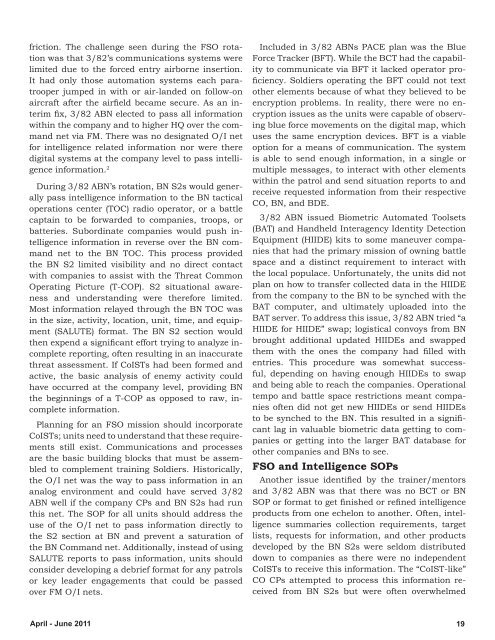George w. casey jr. - Federation of American Scientists
George w. casey jr. - Federation of American Scientists
George w. casey jr. - Federation of American Scientists
You also want an ePaper? Increase the reach of your titles
YUMPU automatically turns print PDFs into web optimized ePapers that Google loves.
friction. The challenge seen during the FSO rotation<br />
was that 3/82’s communications systems were<br />
limited due to the forced entry airborne insertion.<br />
It had only those automation systems each paratrooper<br />
jumped in with or air-landed on follow-on<br />
aircraft after the airfield became secure. As an interim<br />
fix, 3/82 ABN elected to pass all information<br />
within the company and to higher HQ over the command<br />
net via FM. There was no designated O/I net<br />
for intelligence related information nor were there<br />
digital systems at the company level to pass intelligence<br />
information. 2<br />
During 3/82 ABN’s rotation, BN S2s would generally<br />
pass intelligence information to the BN tactical<br />
operations center (TOC) radio operator, or a battle<br />
captain to be forwarded to companies, troops, or<br />
batteries. Subordinate companies would push intelligence<br />
information in reverse over the BN command<br />
net to the BN TOC. This process provided<br />
the BN S2 limited visibility and no direct contact<br />
with companies to assist with the Threat Common<br />
Operating Picture (T-COP). S2 situational awareness<br />
and understanding were therefore limited.<br />
Most information relayed through the BN TOC was<br />
in the size, activity, location, unit, time, and equipment<br />
(SALUTE) format. The BN S2 section would<br />
then expend a significant effort trying to analyze incomplete<br />
reporting, <strong>of</strong>ten resulting in an inaccurate<br />
threat assessment. If CoISTs had been formed and<br />
active, the basic analysis <strong>of</strong> enemy activity could<br />
have occurred at the company level, providing BN<br />
the beginnings <strong>of</strong> a T-COP as opposed to raw, incomplete<br />
information.<br />
Planning for an FSO mission should incorporate<br />
CoISTs; units need to understand that these requirements<br />
still exist. Communications and processes<br />
are the basic building blocks that must be assembled<br />
to complement training Soldiers. Historically,<br />
the O/I net was the way to pass information in an<br />
analog environment and could have served 3/82<br />
ABN well if the company CPs and BN S2s had run<br />
this net. The SOP for all units should address the<br />
use <strong>of</strong> the O/I net to pass information directly to<br />
the S2 section at BN and prevent a saturation <strong>of</strong><br />
the BN Command net. Additionally, instead <strong>of</strong> using<br />
SALUTE reports to pass information, units should<br />
consider developing a debrief format for any patrols<br />
or key leader engagements that could be passed<br />
over FM O/I nets.<br />
Included in 3/82 ABNs PACE plan was the Blue<br />
Force Tracker (BFT). While the BCT had the capability<br />
to communicate via BFT it lacked operator pr<strong>of</strong>iciency.<br />
Soldiers operating the BFT could not text<br />
other elements because <strong>of</strong> what they believed to be<br />
encryption problems. In reality, there were no encryption<br />
issues as the units were capable <strong>of</strong> observing<br />
blue force movements on the digital map, which<br />
uses the same encryption devices. BFT is a viable<br />
option for a means <strong>of</strong> communication. The system<br />
is able to send enough information, in a single or<br />
multiple messages, to interact with other elements<br />
within the patrol and send situation reports to and<br />
receive requested information from their respective<br />
CO, BN, and BDE.<br />
3/82 ABN issued Biometric Automated Toolsets<br />
(BAT) and Handheld Interagency Identity Detection<br />
Equipment (HIIDE) kits to some maneuver companies<br />
that had the primary mission <strong>of</strong> owning battle<br />
space and a distinct requirement to interact with<br />
the local populace. Unfortunately, the units did not<br />
plan on how to transfer collected data in the HIIDE<br />
from the company to the BN to be synched with the<br />
BAT computer, and ultimately uploaded into the<br />
BAT server. To address this issue, 3/82 ABN tried “a<br />
HIIDE for HIIDE” swap; logistical convoys from BN<br />
brought additional updated HIIDEs and swapped<br />
them with the ones the company had filled with<br />
entries. This procedure was somewhat successful,<br />
depending on having enough HIIDEs to swap<br />
and being able to reach the companies. Operational<br />
tempo and battle space restrictions meant companies<br />
<strong>of</strong>ten did not get new HIIDEs or send HIIDEs<br />
to be synched to the BN. This resulted in a significant<br />
lag in valuable biometric data getting to companies<br />
or getting into the larger BAT database for<br />
other companies and BNs to see.<br />
FSO and Intelligence SOPs<br />
Another issue identified by the trainer/mentors<br />
and 3/82 ABN was that there was no BCT or BN<br />
SOP or format to get finished or refined intelligence<br />
products from one echelon to another. Often, intelligence<br />
summaries collection requirements, target<br />
lists, requests for information, and other products<br />
developed by the BN S2s were seldom distributed<br />
down to companies as there were no independent<br />
CoISTs to receive this information. The “CoIST-like”<br />
CO CPs attempted to process this information received<br />
from BN S2s but were <strong>of</strong>ten overwhelmed<br />
April - June 2011 19















